This article was co-authored by Laura Flinn and by wikiHow staff writer, Jennifer Mueller, JD. Laura Flinn is a National Academy of Sports Medicine (NASM) Certified Personal Trainer, USA Olympic Weightlifting Sports Performance Coach and Certified Fitness Nutritionist, with an additional qualification as a TRX Suspension Trainer. Laura runs her own personal training program based in the San Francisco Bay Area and specializes in topics such as weight loss, muscle growth, cardiovascular training, and strength training.
There are 11 references cited in this article, which can be found at the bottom of the page.
This article has been viewed 197,150 times.
The tibialis anterior is the muscle that runs along your shins from your ankle to your knee.[1] If you flex your foot upward, pulling your toes toward your shins, you may be able to see it contracting. This muscle opposes the calf muscles on the back of your lower leg, and imbalances between these muscles can lead to pain or injury. However, this muscle is frequently neglected by even the most dedicated exercise enthusiasts and body builders. To exercise your tibialis anterior, use resistance to strengthen and stretch the muscle in conjunction with overall conditioning of the rest of your lower body.[2]
Steps
Strengthening Your Tibialis Anterior
-
1Start with toe raises. This exercise strengthens your tibialis anterior and other tendons and muscles running along your shins. If you have extremely weak shins, or are recovering from a recent injury, this is one of the first movements you should do to exercise your tibialis anterior.[3]
- Initially, do this exercise from a seated position. Find a chair you can sit in with good posture and your feet firmly on the floor in front of you. Slowly raise your toes and the front of your foot off the floor toward your shins, digging your heels into the floor.
- When you've raised your toes as far as you can without pain, hold the position for a couple of seconds, then slowly release your foot to the floor. Try to do 10 to 15 repetitions of this exercise. You can do each foot individually or do them both at the same time.
- After you've been doing seated toe raises for a couple of weeks, try standing toe raises. Make sure you have something to hold onto so you can balance and stand with good posture.
- You can use resistance bands to make this exercise even more challenging and further strengthen your tibialis anterior.
-
2Use a resistance band to stretch more effectively. You can strengthen your tibialis anterior muscle specifically with an elastic resistance bands.[4] If you're currently in physical therapy for an injury, you may be able to get one from your physical therapist. Otherwise, you can buy them at any sporting goods store, typically for less than $20.[5]
- To exercise your tibialis anterior with a resistance band, tie one end of the band around a heavy, stable object, such as a table or sofa. Loop the other end of the band around your foot and tie it to secure it.
- Pull your toes and foot up and toward your shins, keeping your knee straight. Go as far as you can without pain. Hold the position for a couple of seconds, then slowly move your foot back to your starting position.[6]
- Do 10 repetitions of this exercise, or until you can no longer do it without pain.
Advertisement -
3Use a cuff weight. Cuff weights provide resistance when doing toe raises to further strengthen your tibialis anterior. You can also do this exercise with a resistance band if you don't have access to cuff weights.[7]
- Cuff weights are available at most sporting goods stores. They typically have removable sand bags so you can customize the amount of weight you're using, and secure around a limb using velcro.
- Sit in a chair and wrap the cuff weight around your foot. Flex your ankle, moving your toes and foot up toward your chin.
- Go as far as you can, then hold your foot there for a couple of seconds before slowly lowering it back to starting position.
- Try to do 10 repetitions, but stop if you can no longer do it without pain.
-
4Try isometric exercise. With isometric exercises, you contract the muscle you want to strengthen without moving your joint. This exercise can strengthen your tibialis anterior and increase the range of motion in your ankle without putting any stress or pressure on the joint.[8]
- Start isometric exercise of your tibialis anterior by sitting in a chair or lying on your back on the floor with your legs out in front of you.
- Cross one leg over the other at the ankles. If your tibialis anterior is weaker in one leg than in the other, you want to start with that leg on the bottom.
- Push the top of your lower foot into the sole of your other foot. Take care not to flex your ankle as you do this.
- Press your feet together for five seconds, then slowly release. Repeat between 10 and 15 times, then re-cross your ankles and do the other leg.
- Varying the position of your ankle enables you to strengthen your tibialis anterior in relation to other ranges of motion.
-
5Progress to smith machine reverse calf raises. If you have access to a gym with weight training equipment, you can use that equipment to further strengthen your tibialis anterior and the rest of the muscles in your lower leg, including your calves.[9]
- To start this exercise, go to the smith machine and stand under the bar with your heels on the platform.
- Rise up on your heels to contract your tibialis anterior. Hold the position for a couple of seconds, then slowly release back to your starting position.
- Do 10 to 15 repetitions of this exercise to exercise your tibialis anterior as well as the surrounding muscles in your lower leg.
-
6Add other weight-training exercises. The reverse variation of any calf exercise will engage and strengthen the tibialis anterior, as well as exercising the rest of your lower leg. Once you've sufficiently strengthened your tibialis anterior so it is in balance with the rest of the muscles in your lower leg, use these exercises to maintain and continually build strength.[10]
- The best way to do this is to do a reverse variation of any calf exercise in your routine. For example, if you do calf raises, you should also do reverse calf raises. This ensures you maintain balance in the muscles in your lower leg.
- These weight-training exercises often are done on weight benches using free weights, or on exercise machines. If you don't have access to a gym, you can do similar exercises at home with dumbbells or resistance bands.
- Start with just your body weight, and slowly add weight or resistance every week or so to continuously challenge and build strength in your tibialis anterior.
Stretching Your Tibialis Anterior
-
1Warm up before stretching. Before you do any stretches, make sure you raise your body temperature a couple of degrees with a low-impact, cardiovascular activity. This will stimulate increased blood flow to your muscles and help prevent strains or other injuries.[11]
- Walking at a brisk pace for five to 10 minutes is a good overall cardiovascular warm-up.
- Squats and lunges also are a good warm-up before you do stretches or strength training on your lower body. Move slowly, but try to do these exercises in fluid motion, so that you're always moving.
- If you have limited space, you also might try jumping jacks or jogging place for five minutes, although these activities involve a little more impact and stress on your joints.
-
2Start with shin stretches. Provided you have never had any ankle injuries, you can do a seated exercise to stretch your tibialis anterior and the other muscles in your shins. These muscles typically are difficult to stretch.[12]
- Kneel on the floor with your shins flat on the ground. Your toes and feet should be pointing behind you. You can rest your hands on the ground beside you.
- To start the shin stretch, slowly lean back to sit on your heels, stopping when you feel the stretch. If you have to, you can put your hands on the ground behind you so you can lean further back.
- Hold the stretch for a couple of minutes, then slowly raise up to release the muscles.
- You can also do a standing shin stretch. Cross your left leg in front of your right, so the tops of the toes of your left foot are resting on the floor. Bend your right knee to press your toes further into the floor until you feel the stretch in your shin. Hold the stretch for a couple of seconds, then slowly release and switch legs.
-
3Do towel calf stretches. When your tibialis anterior is weak, it can keep you from being able to fully flex your foot. Over time, this can cause your calves to become shortened and tightened, which can exacerbate any lower leg problems.[13]
- You also can do this exercise with a resistance band, but using a rolled towel allows you to better control the level of resistance.[14]
- Sit up straight with your legs out in front of you. Wrap the towel around the balls of your feet, then pull the ends of the towel toward you so that your foot flexes up.
- Hold the stretch for 15 to 30 seconds, feeling the stretch in your calf. Then slowly release.
- You can safely do this stretch three to five times a day if you have particularly tight calves.
-
4Add standing calf stretches. Standing calf stretches are a more intense stretch than the calf stretches you do while sitting, because you are working with your body weight and gravity as resistance.[15]
- Start your standing calf stretch by standing a few feet in front of a wall or other stable vertical surface. Place your hands on the wall about shoulder-width apart and drop one leg behind you.
- Push the heel of your rear leg into the floor, keeping your back and leg straight. Your front knee should be bent.
- Without bouncing, push your heel down into the floor until you feel a stretch in your calf. Hold the stretch for a few seconds, then release slowly and switch legs.
- You also can do calf stretches on stairs. To do a standing gastrocnemius calf stretch, which stretches one of the two muscles in your calves, place one heel on a step and extend your knee. Your other foot should be flat on the floor. Grab the toe of the front foot and pull your toes toward your shins. You should feel a pull in your calf. Hold for a couple of seconds, then slowly release and do the other leg.
- Stand on a step with the balls of your feet firmly on the step and your heels over the edge. Make sure you have something to hold onto for balance, and lower your heels as far as you can without pain. Hold for a couple of seconds, then slowly raise your heels back up.
Conditioning Your Shins and Calves
-
1Run barefoot on a grassy surface. Running or walking barefoot on an uneven, grassy surface can evenly strengthen and condition all five muscles in your calves and shins simultaneously.[16]
- You should only do this when it's relatively warm outside. Keep in mind the ground is often going to be colder than the outside air temperature, and you lose a lot of body heat through your feet.
- Make sure the surface is relatively well-maintained and free of debris. Athletic fields or golf courses can be good options.
- Start slow, going no more than a half-mile (about 800 meters) to start. This will give your legs, feet, and ankles time to adjust to walking or running barefoot.
-
2Run or walk on an incline. Incline and hill work exercise your tibialis anterior to a degree that running or walking on a flat surface cannot, because your toes are higher than your heels. Since you're running or walking at a slower rate of speed, you also decrease your risk of injury because you have more control over your form.[17]
- If you live in a relatively hilly area, adding incline work to your cardio routine can be as simple as making sure your walking or running route includes several hills.
- In a gym, increase the incline on a treadmill to simulate walking or running on a hill.
- Make sure you warm up your muscles by walking or running on a flat surface for 5 to 10 minutes before going into any incline or hill work.
-
3Jump rope. Jumping rope is a good conditioning exercise that works your entire body as well as conditioning the muscles in your shins and calves, including your tibialis anterior. A fitness jump rope is a relatively inexpensive exercise tool that you can find in any sporting goods store.[18]
- You can add jumping rope to your overall regimen and do it for five to ten minutes, then rest for a minute or two.
- Another option is to add jump-rope intervals of 30 seconds to a minute in between strength-training exercises. These can be especially beneficial to continue to condition the muscles in your lower legs even while doing upper body exercises.
-
4Walk or skip on your toes. Walking or skipping on your toes works all the muscles in your lower leg, particularly your calves. This conditioning exercise also gives you a good cardiovascular workout, and can be used as a warm-up before lower-leg strength training or stretching.[19]
- If you're adding this exercise as an interval to your workout regime, you can go for a set period of time (such as 5 or 10 minutes), or for a set distance (no more than 20 meters or about 65 feet per interval).
-
5Walk on your heels. This activity provides intense exercise for your tibialis anterior, as your feet are in the same position they would be in if you were doing toe raises to strengthen your shin muscles.[20]
- As an interval, do this for 5 to 10 minutes in between other strength-training exercises. Try to place a heel-walking interval between exercises that don't focus on your lower legs.
- You also can add heel walking to your regimen as an exercise in and of itself. Try to walk on your heels for about 20 meters or 65 feet to start, increasing your distance incrementally with each workout session.
Expert Q&A
Did you know you can get expert answers for this article?
Unlock expert answers by supporting wikiHow
-
QuestionWhat exercises work the tibialis anterior?
 Laura FlinnLaura Flinn is a National Academy of Sports Medicine (NASM) Certified Personal Trainer, USA Olympic Weightlifting Sports Performance Coach and Certified Fitness Nutritionist, with an additional qualification as a TRX Suspension Trainer. Laura runs her own personal training program based in the San Francisco Bay Area and specializes in topics such as weight loss, muscle growth, cardiovascular training, and strength training.
Laura FlinnLaura Flinn is a National Academy of Sports Medicine (NASM) Certified Personal Trainer, USA Olympic Weightlifting Sports Performance Coach and Certified Fitness Nutritionist, with an additional qualification as a TRX Suspension Trainer. Laura runs her own personal training program based in the San Francisco Bay Area and specializes in topics such as weight loss, muscle growth, cardiovascular training, and strength training.
NASM Certified Personal Trainer Take a seat in a chair so that your knees bend at a 90-degree angle. Make sure that when you are sitting down, your back is straight and your hips are forward in the chair. Wrap a resistance band around the ball of your foot and lift your leg in the air. You want to get your leg at least parallel to the floor, but if you can lift it higher then you should. Keep the other foot firmly planted on the ground. Then, point your toes as far as you can and hold this position for 2-5 seconds. Pointing your toes will flex the ankle and stretch the tibialis anterior. After a few seconds, release the position but don't put your foot back down on the ground. Repeat this motion 10-15 times. After doing enough reps to tire out your anterior tibialis on one leg, switch and do this whole exercise on the other leg.
Take a seat in a chair so that your knees bend at a 90-degree angle. Make sure that when you are sitting down, your back is straight and your hips are forward in the chair. Wrap a resistance band around the ball of your foot and lift your leg in the air. You want to get your leg at least parallel to the floor, but if you can lift it higher then you should. Keep the other foot firmly planted on the ground. Then, point your toes as far as you can and hold this position for 2-5 seconds. Pointing your toes will flex the ankle and stretch the tibialis anterior. After a few seconds, release the position but don't put your foot back down on the ground. Repeat this motion 10-15 times. After doing enough reps to tire out your anterior tibialis on one leg, switch and do this whole exercise on the other leg.
References
- ↑ http://www.exrx.net/Muscles/TibialisAnterior.html
- ↑ http://www.bodybuilding.com/fun/wotw50.htm
- ↑ http://www.sportsinjuryclinic.net/rehabilitation-exercises/lower-leg-ankle-exercises/toe-raise
- ↑ Laura Flinn. NASM Certified Personal Trainer. Expert Interview. 18 November 2019.
- ↑ http://orthoinfo.org/PDFs/Rehab_Foot_and_Ankle_4.pdf
- ↑ Laura Flinn. NASM Certified Personal Trainer. Expert Interview. 18 November 2019.
- ↑ https://www.verywell.com/exercise-program-to-correct-foot-drop-2696048
- ↑ https://www.verywell.com/exercise-program-to-correct-foot-drop-2696048
- ↑ http://www.bodybuilding.com/fun/wotw50.htm
- ↑ http://www.exrx.net/Lists/ExList/CalfWt.html
- ↑ http://www.bodybuilding.com/fun/wotw50.htm
- ↑ http://www.sportsinjuryclinic.net/rehabilitation-exercises/stretching-exercises/shin-stretch
- ↑ https://www.verywell.com/exercise-program-to-correct-foot-drop-2696048
- ↑ Laura Flinn. NASM Certified Personal Trainer. Expert Interview. 18 November 2019.
- ↑ http://www.bodybuilding.com/fun/wotw50.htm
- ↑ https://www.brianmac.co.uk/articles/scni2a3.htm
- ↑ https://breakingmuscle.com/learn/how-and-why-to-run-hill-sprint-intervals
- ↑ http://www.bodybuilding.com/fun/wotw50.htm
- ↑ https://www.brianmac.co.uk/articles/scni2a3.htm
- ↑ https://www.brianmac.co.uk/articles/scni2a3.htm
- ↑ https://runnersconnect.net/running-injury-prevention/shin-splint-exercises/
- ↑ http://www.bodybuilding.com/fun/wotw50.htm
About This Article
Your tibialis anterior is the muscle that runs along your shins from your ankle to your knee. Before you exercise it, warm up your shins by going on a brisk walk, then stretching your legs. Kneeling on the ground and slowly leaning back is a good way to stretch them. Once you’re warmed up, try doing toe raises from a seated position 10-15 times. You can also walk on your toes, run on an incline, or jump rope to strengthen your calves. If you have access to a gym, try doing calf raises with a bar weight for an extra workout. To learn how to use a resistance band to exercise your tibialis anterior, read more from our Training co-author!

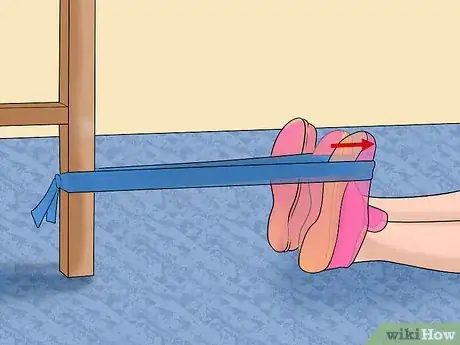

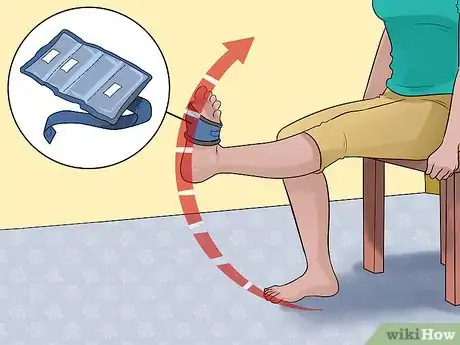
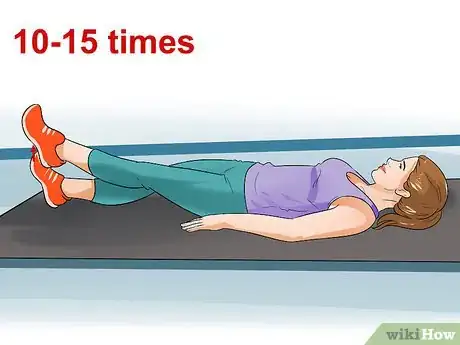

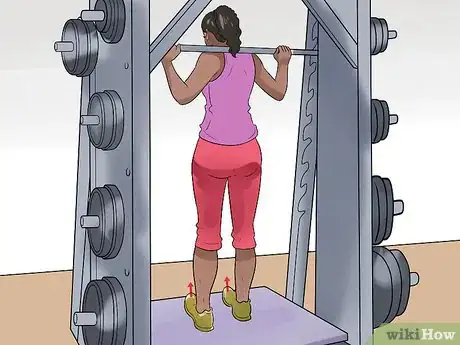
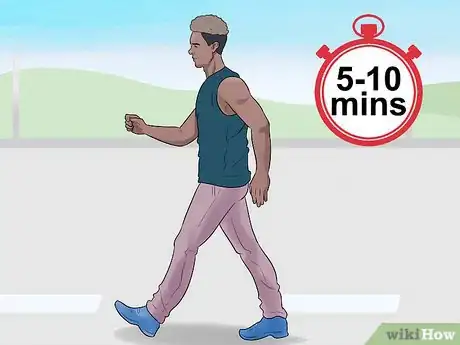

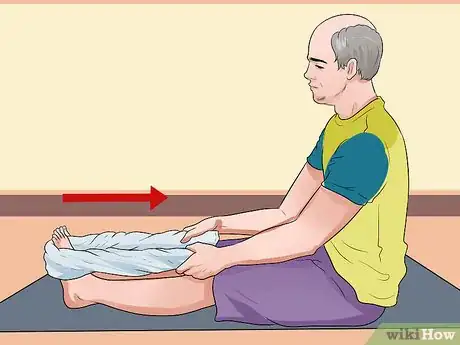
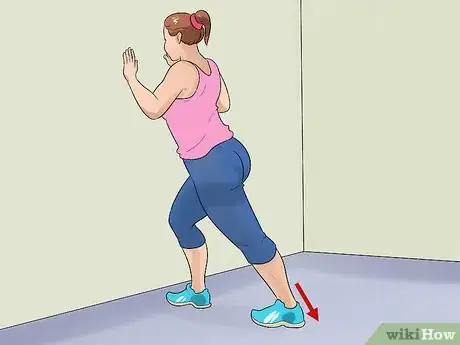
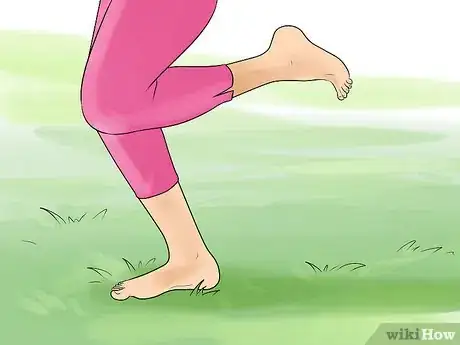
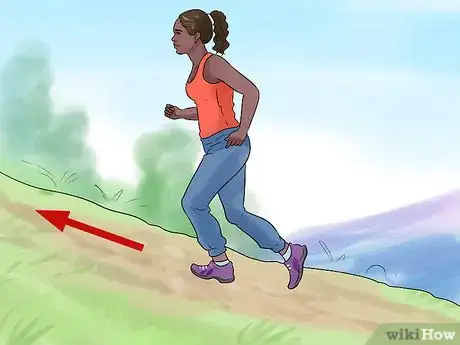
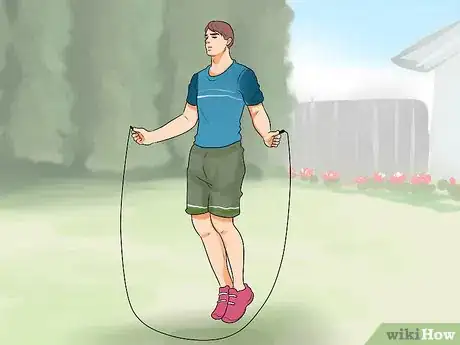
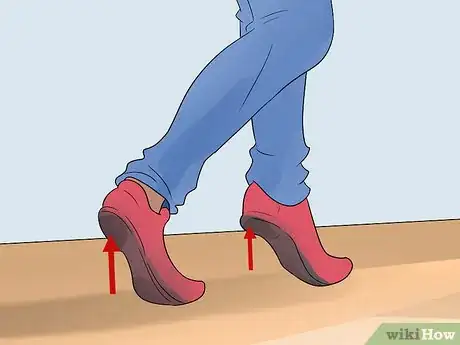

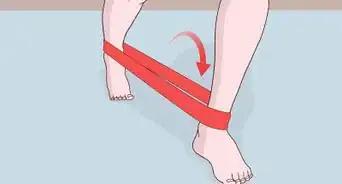




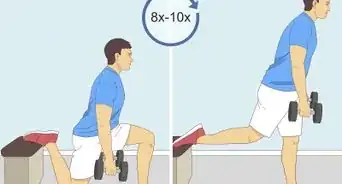

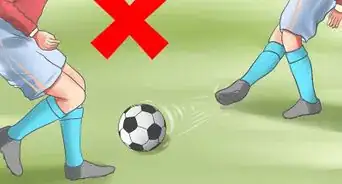
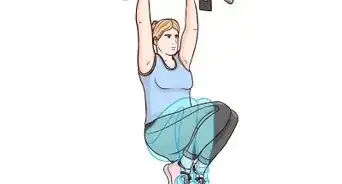










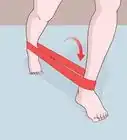






































Medical Disclaimer
The content of this article is not intended to be a substitute for professional medical advice, examination, diagnosis, or treatment. You should always contact your doctor or other qualified healthcare professional before starting, changing, or stopping any kind of health treatment.
Read More...